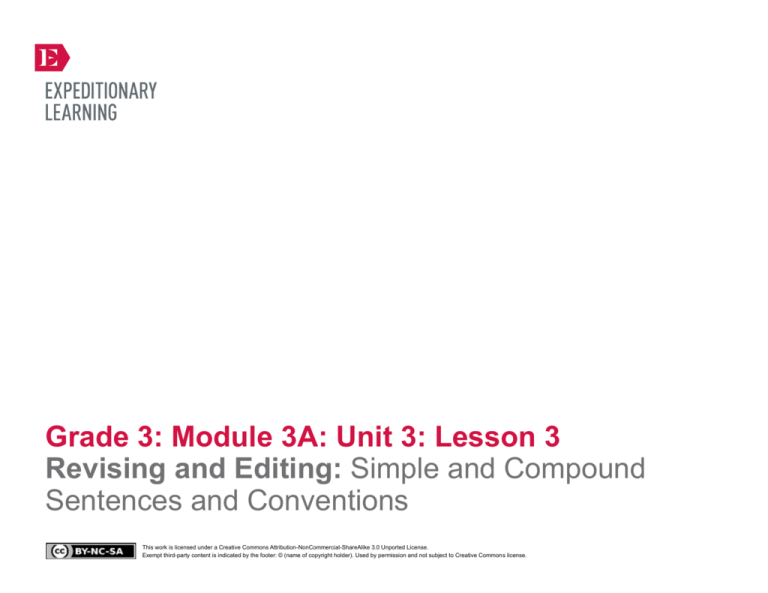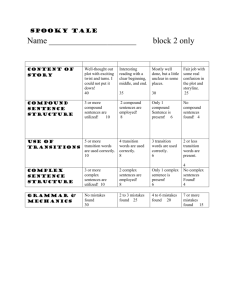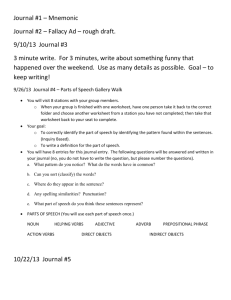
Grade 3: Module 3A: Unit 3: Lesson 3
Revising and Editing: Simple and Compound
Sentences and Conventions
This work is licensed under a Creative Commons Attribution-NonCommercial-ShareAlike 3.0 Unported License.
Exempt third-party content is indicated by the footer: © (name of copyright holder). Used by permission and not subject to Creative Commons license.
GRADE 3: MODULE 3A: UNIT 3: LESSON 3
Revising and Editing:
Simple and Compound Sentences and Conventions
Long-Term Targets Addressed (Based on NYSP12 ELA CCLS)
I can write simple, complex, and compound sentences. (L.3.1)
I can use conventions to send a clear message to my reader. (L.3.2)
I can use the writing process to plan, revise, and edit my writing (with support). (W.3.5)
Supporting Learning Targets
Ongoing Assessment
• I can revise my Peter Pan summary paragraph to include simple and compound sentences.
• Students’ sentence revisions
• I can capitalize appropriate words in titles.
• Students’ edited writing
• I can correctly spell words that have suffixes.
• I can use resources to check and correct my spelling.
Copyright © 2013 by Expeditionary Learning, New York, NY. All Rights Reserved.
NYS Common Core ELA Curriculum • G3:M3A:U3:L3 • June 2014 •
1
GRADE 3: MODULE 3A: UNIT 3: LESSON 3
Revising and Editing:
Simple and Compound Sentences and Conventions
Agenda
Teaching Notes
1. Opening
• This lesson includes just 15 minutes for students to edit their summary paragraphs. If they do not finish
the task, decide whether to assign it as homework or provide additional class time to complete the
editing.
A. Unpacking the Learning Targets (5 minutes)
2. Work Time
B. Revision Work Time (15 minutes)
• These lessons do not dedicate time to publishing (typing or rewriting in best handwriting) students’
summaries. Plan accordingly, making arrangements for technology time if students will type their
summaries. If students are handwriting their summaries, plan to have them complete this after Lesson 3
(during another time of the day or for homework before Lesson 4).
C. Editing Work Time (15 minutes)
• Review: Conventions checklist (used in Modules 1 and 2; see supporting materials)
A. Mini Lesson: Simple and Complex Sentences (20
minutes)
3. Closing and Assessment
• Review: Concentric Circles protocol (see Appendix)
A. Share: Concentric Circles (5 minutes)
4. Homework
A. Complete the Simple and Compound Sentences
homework sheet.
Lesson Vocabulary
Materials
revise, simple, compound, conjunction
• Simple and Compound Sentences recording form (one per student)
• Classic Starts edition of Peter Pan (one per pair)
• Rain School Model Summary (from Lesson 1)
• First drafts of students’ Peter Pan summary (from Lesson 2)
• Conventions checklist (one for display)
• Simple and Compound Sentences homework (one per student)
Copyright © 2013 by Expeditionary Learning, New York, NY. All Rights Reserved.
NYS Common Core ELA Curriculum • G3:M3A:U3:L3 • June 2014 •
2
GRADE 3: MODULE 3A: UNIT 3: LESSON 3
Revising and Editing:
Simple and Compound Sentences and Conventions
Meeting Students’ Needs
Opening
A. Unpacking the Learning Targets (5 minutes)
• Congratulate students on their first draft writing from Lesson 2. Remind them that effective writers always revise, or look at
their writing again and change things to make it stronger. (If necessary, refer to the writing process to clarify where students
are in their journey as writers.)
• Read aloud the first target. Remind students that they have already worked hard to revise their writing this year. Point out
that the word revise means literally “to look again.” The prefix “re” means again, and “vise” means look. They are looking at
their writing again to see how to make it even better. Underline the words simple and complex. Invite students to pair share
what they know about these words.
• Define them for students:
simple = easy or basic
compound = made up of two parts (tell students that the prefix “com-” means together)
• Tell the class that experienced writers use both simple and compound sentences. Ask students why writers might consider
the variety of their sentences.
• If necessary, guide students toward the understanding that sentence variety makes their writing interesting and lively. Too
many simple sentences, for example, will sound choppy, but too many long sentences will be difficult to read and hard to
understand. Later in the lesson, they will revise their paragraphs to write a variety of sentences and make their writing more
interesting.
• Direct students to the next three targets and read them aloud. Again, ask students to pair share what they think they will be
doing in the second part of the lesson based on these targets. Students are very familiar with these targets and should be able
to easily identify that they will edit, or polish, their writing to make it easier to read.
Copyright © 2013 by Expeditionary Learning, New York, NY. All Rights Reserved.
NYS Common Core ELA Curriculum • G3:M3A:U3:L3 • June 2014 •
3
GRADE 3: MODULE 3A: UNIT 3: LESSON 3
Revising and Editing:
Simple and Compound Sentences and Conventions
Work Time
Meeting Students’ Needs
A. Mini Lesson: Simple and Complex Sentences (20 minutes)
• Project Part A of the Simple and Compound Sentences recording form. Read the definitions and examples of a
simple sentence aloud to students. Invite students to pair share what makes those two sentences simple.
• All students developing academic
language will benefit from direct
instruction of academic vocabulary.
• Repeat with the compound sentence definition and examples. Again, invite students to pair share what makes those two
sentences compound. Reinforce the conjunctions used in both sentences, so and but.
• Consider strategic pairs of students
for the Simple and Compound
Sentences activity in Work Time A.
• Distribute the Classic Starts edition of Peter Pan to students as well as the Simple and Compound Sentences recording
form. Give students about 10 minutes to complete Part B of the recording form with a partner. After students have
completed the form, discuss this section as a class and answer any clarifying questions as needed. Students should have
pulled out the following compound sentences from the Peter Pan text:
– This would not have been fighting fair, so Peter offered Hook a hand to hoist himself up.
– People had been unfair to Peter before, but he had always forgotten it, and so he reacted as if it were the first time.
• Consider writing and breaking down
multistep directions into numbered
elements. Struggling learners can
return to these guidelines to make
sure they are on track.
– Hook clawed Peter twice with his hook, and might have finished him off had he not just then heard a ticking.
• Display the Rain School Model Summary. Say to students: “Let’s look together again at the model summary.
Remember, we are trying to have both simple and compound sentences in our paragraphs so they are more interesting to
read. As I read the paragraph aloud, look and listen for simple and compound sentences.”
• Read the paragraph aloud as students follow along. After reading, invite students to pair share one simple sentence that they
noticed in the paragraph. Listen for students to name the following sentences:
– Rain School is a powerful story about Thomas, a boy who lives in the country of Chad.
– Thomas is very excited to be going to school.
– His teacher says that building the school will be the children’s first lesson.
– He and the other children help to build the schoolhouse from mud and grass.
– Then they get to learn how to read and write with their wonderful teacher.
– Thomas and the other children are not sad.
Copyright © 2013 by Expeditionary Learning, New York, NY. All Rights Reserved.
NYS Common Core ELA Curriculum • G3:M3A:U3:L3 • June 2014 •
4
GRADE 3: MODULE 3A: UNIT 3: LESSON 3
Revising and Editing:
Simple and Compound Sentences and Conventions
Meeting Students’ Needs
Work Time (continued)
– The teacher tells the children that they will rebuild the school again next year.
• Consider pulling a small group of
students who might need targeted
support with their drafting.
– It was interesting to read about a school so far away.
• Cold call students to share the simple sentences they identified and highlight them.
• Next, invite students to pair share a compound sentence they noticed. Listen for students to name any of the following:
– He goes to school on the first day, but he realizes that there is no school building.
– At the end of the school year big rains come, and they totally wash the school building away.
– Thomas’s school is like our school, since kids learn to read and write, but also very different from our school.
• Tell students that you are going to show them how thoughtful writers might revise their writing to include a variety of
sentences. Ask them to watch and listen carefully and track what you do as a writer to make revisions on your first draft.
• Read aloud these sentences: “His teacher says that building the school will be the children’s first lesson. He and the other
children help to build the schoolhouse from mud and grass.”
• Think aloud: “These are both simple sentences. I think I could combine them into a compound sentence using the
conjunction so. Let me see how that sounds: ‘His teacher says that building the school will be the children’s first lesson, so he
and the other children help to build the schoolhouse from mud and grass.’”
• Write above your original sentences, inserting a caret mark or a V to show that you are adding something to the writing.
• Reread the sentence: “His teacher says that building the school will be the children’s first lesson, so he and the other children
help to build the schoolhouse from mud and grass.”
• Think aloud: “I think that sounds more interesting and less choppy.” Point out that the word “and” in this sentence is not
used as a conjunction to join two simple sentences; rather, it’s showing that the houses were built of grass as well as mud.
• Explain to students that they are going to do the same thing you just did. They are going to revise their writing, looking for
places where they might be able to combine two simple sentences into a compound sentence. There may also be a place
where they could break a compound sentence into two simple ones. Refer them to the target for the day again.
Copyright © 2013 by Expeditionary Learning, New York, NY. All Rights Reserved.
NYS Common Core ELA Curriculum • G3:M3A:U3:L3 • June 2014 •
5
GRADE 3: MODULE 3A: UNIT 3: LESSON 3
Revising and Editing:
Simple and Compound Sentences and Conventions
Meeting Students’ Needs
Work Time (continued)
B. Revision Work Time (15 minutes)
• Distribute first drafts of students’ Peter Pan summaries.
• Give the class 15 minutes to revise individually or in pairs. Circulate and confer with students as they revise their drafts.
• If students are stuck, provide further instruction by helping them identify sentences that could be combined or broken up.
Remind students to use their Simple and Compound Sentences recording form if they need support.
• Pull invitational groups as needed. An invitational group might look like the following:
1. Gather the group with their first drafts and Simple and Compound Sentences recording forms.
2. Have students reread their own first drafts, looking for simple and compound sentences.
3. Review the recording form and ask students to think about their sentences.
4. Give students an opportunity to share with each other what they decided to do to combine or break up sentences.
Depending on the group size, pair them together for this or ask each student to share with the whole group.
Copyright © 2013 by Expeditionary Learning, New York, NY. All Rights Reserved.
NYS Common Core ELA Curriculum • G3:M3A:U3:L3 • June 2014 •
6
GRADE 3: MODULE 3A: UNIT 3: LESSON 3
Revising and Editing:
Simple and Compound Sentences and Conventions
Meeting Students’ Needs
Work Time (continued)
C. Editing Work Time (15 minutes)
• Project the Conventions checklist. Briefly review the contents of the checklist. This tool is very familiar to students, so
they will likely need little, if any, clarification. Remind students to use their checklists to identify what they need to work on
to edit their writing.
• Give students about 15 minutes to edit their writing for correct capitalization, spelling, and punctuation. Invite students to
work in partnerships or small groups, reading their work aloud to each other to support their editing process.
• Confer and support as needed.
• For students who might have a difficult time finding their own errors, consider the following options:
– Support them by identifying a few words to correct.
– Gather a small group of students who might need this support so that they can help each other, with your guidance.
– For students struggling to find punctuation corrections, read their writing aloud to them, emphasizing the missing
punctuation (i.e., not pausing). Ask students to listen for a place for you to pause that makes sense.
• After 15 minutes, pause students in their work and ask them to look over their Conventions checklist and check their work
against it. Ask students to complete the checklist, marking where they think their writing is at this point.
• If some students finish earlier than the allotted time, invite them to continue in their independent reading book or rereading
favorite passages of Peter Pan.
Copyright © 2013 by Expeditionary Learning, New York, NY. All Rights Reserved.
NYS Common Core ELA Curriculum • G3:M3A:U3:L3 • June 2014 •
7
GRADE 3: MODULE 3A: UNIT 3: LESSON 3
Revising and Editing:
Simple and Compound Sentences and Conventions
Closing and Assessment
Meeting Students’ Needs
A. Share: Concentric Circles (5 minutes)
• Invite students to bring their revised paragraphs and gather in the configuration for Concentric Circles. (Half the students
form an inside circle, facing out; the others form an outer circle, facing in. All students should be facing a partner; if
numbers are uneven, use a trio.)
• For students needing additional
supports, consider offering a
sentence frame, sentence starter, or
cloze sentence to assist with
language production and provide
the structure required.
• Prompt them to one or two sentences that they revised during today’s writing.
• As students share with a peer, they may use the sentence frame: “I changed the sentence(s) _____ to _______. I think this
will improve my writing because _______.” Be sure each person has a chance to speak.
• Ask students to rotate to the left. Repeat the share two more times.
Homework
Meeting Students’ Needs
• Complete the Simple and Compound Sentences homework sheet.
Copyright © 2013 by Expeditionary Learning, New York, NY. All Rights Reserved.
NYS Common Core ELA Curriculum • G3:M3A:U3:L3 • June 2014 •
8
Grade 3: Module 3A: Unit 3: Lesson 3
Supporting Materials
This work is licensed under a Creative Commons Attribution-NonCommercial-ShareAlike 3.0 Unported License.
Exempt third-party content is indicated by the footer: © (name of copyright holder). Used by permission and not subject to Creative Commons license.
GRADE 3: MODULE 3A: UNIT 3: LESSON 3
Simple and Compound Sentences Recording Form
Name:
Date:
Part A: Simple and Compound Sentences
A simple sentence contains a subject and a verb and shows a complete thought.
Examples:
• I ran to the park yesterday afternoon.
• José and Kelly played on the playground after school.
A compound sentence is two simple sentences joined by a conjunction. A conjunction is a
connecting word like or, and, nor, but, or, yet, so.
Examples:
• Alejandro played football, so Maria went biking.
• I went to bed early, but my brother stayed up late.
Part B: Finding Compound Sentences in Peter Pan
Directions: Please turn to page 78 in your Classic Starts Peter Pan text. Read this page with your
partner and try to find at least two compound sentences.
Copyright © 2013 by Expeditionary Learning, New York, NY. All Rights Reserved.
NYS Common Core ELA Curriculum • G3:M3A:U3:L3 • June 2014 •
10
GRADE 3: MODULE 3A: UNIT 3: LESSON 3
Conventions Checklist
I can use conventions to send a clear message to my reader.
I can use beginning and ending punctuation.
I can capitalize character names and titles.
Copyright © 2013 by Expeditionary Learning, New York, NY. All Rights Reserved.
NYS Common Core ELA Curriculum • G3:M3A:U3:L3 • June 2014 •
11
GRADE 3: MODULE 3A: UNIT 3: LESSON 3
Simple and Compound Sentences Homework
Name:
Date:
Part A: Simple and Compound Sentences
A simple sentence contains a subject and a verb and shows a complete thought.
Examples:
• I ran to the park yesterday afternoon.
• José and Kelly played on the playground after school.
A compound sentence is two simple sentences joined by a conjunction. A conjunction is a
connecting word like or, and, nor, but, or, yet, so.
Examples:
• Alejandro played football, so Maria went biking.
• I went to bed early, but my brother stayed up late.
Part B: Are these sentences simple or compound?
1. My dog runs around the house, but my cat likes to sleep on the couch.
2. Alicia goes to the library and studies every day.
3. My mom and dad like the beach, but my sister and I prefer the mountains.
Copyright © 2013 by Expeditionary Learning, New York, NY. All Rights Reserved.
NYS Common Core ELA Curriculum • G3:M3A:U3:L3 • June 2014 •
12
GRADE 3: MODULE 3A: UNIT 3: LESSON 3
Simple and Compound Sentences Homework
4. Juan and Arturo play soccer every afternoon.
Part C: Combine these two simple sentences with a conjunction to form a compound sentence.
I play the piano. My sister plays the flute.
Copyright © 2013 by Expeditionary Learning, New York, NY. All Rights Reserved.
NYS Common Core ELA Curriculum • G3:M3A:U3:L3 • June 2014 •
13










